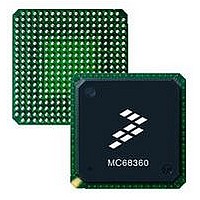MC68EN360CAI25L Freescale Semiconductor, MC68EN360CAI25L Datasheet - Page 188

MC68EN360CAI25L
Manufacturer Part Number
MC68EN360CAI25L
Description
IC MPU QUICC 25MHZ 240-FQFP
Manufacturer
Freescale Semiconductor
Series
MC68000r
Datasheets
1.MC68EN302AG20BT.pdf
(8 pages)
2.MC68EN360VR25L.pdf
(14 pages)
3.MC68EN360VR25L.pdf
(2 pages)
4.MC68EN360CAI25L.pdf
(962 pages)
Specifications of MC68EN360CAI25L
Processor Type
M683xx 32-Bit
Speed
25MHz
Voltage
5V
Mounting Type
Surface Mount
Package / Case
240-FQFP
Core Size
32 Bit
Cpu Speed
25MHz
Embedded Interface Type
SCP, TDM
Digital Ic Case Style
FQFP
No. Of Pins
240
Supply Voltage Range
4.75V To 5.25V
Rohs Compliant
Yes
Family Name
M68xxx
Device Core
ColdFire
Device Core Size
32b
Frequency (max)
25MHz
Instruction Set Architecture
RISC
Supply Voltage 1 (typ)
5V
Operating Supply Voltage (max)
5.25V
Operating Supply Voltage (min)
4.75V
Operating Temp Range
-40C to 85C
Operating Temperature Classification
Industrial
Mounting
Surface Mount
Pin Count
240
Package Type
FQFP
Lead Free Status / RoHS Status
Lead free / RoHS Compliant
Features
-
Lead Free Status / Rohs Status
Compliant
Available stocks
Company
Part Number
Manufacturer
Quantity
Price
Company:
Part Number:
MC68EN360CAI25L
Manufacturer:
APLHA
Quantity:
12 000
Company:
Part Number:
MC68EN360CAI25L
Manufacturer:
Freescale Semiconductor
Quantity:
10 000
Part Number:
MC68EN360CAI25L
Manufacturer:
FREESCALE
Quantity:
20 000
- MC68EN302AG20BT PDF datasheet
- MC68EN360VR25L PDF datasheet #2
- MC68EN360VR25L PDF datasheet #3
- MC68EN360CAI25L PDF datasheet #4
- Current page: 188 of 962
- Download datasheet (4Mb)
Freescale Semiconductor, Inc.
CPU32+
At the present time, T1–T0 = 11 is an undefined condition. It is reserved by Motorola for
future use.
Exception processing for trace starts at the end of normal processing for the traced instruc-
tion and before the start of the next instruction. Exception processing follows the regular
sequence; tracing is disabled so that the trace exception itself is not traced. A vector number
is generated to reference the trace exception vector. The address of the instruction that
caused the trace exception, the trace exception vector offset, the current PC, and a copy of
the SR are saved on the supervisor stack. The saved value of the PC is the address of the
next instruction to be executed.
A trace exception can be viewed as an extension to the function of any instruction. If a trace
exception is generated by an instruction, the execution of that instruction is not complete
until the trace exception processing associated with it is also complete.
If an instruction is aborted by a bus error or address error exception, trace exception pro-
cessing is deferred until the suspended instruction is restarted and completed normally. An
RTE from a bus error or address error will not be traced because of the possibility of con-
tinuing the instruction from the fault.
If an instruction is executed and an interrupt is pending on completion, the trace exception
is processed before the interrupt exception.
If an instruction forces an exception, the forced exception is processed before the trace
exception.
If an instruction is executed and a breakpoint is pending upon completion of the instruction,
the trace exception is processed before the breakpoint.
If an attempt is made to execute an illegal, unimplemented, or privileged instruction while
tracing is enabled, no trace exception will occur because the instruction is not executed. This
is particularly important to an emulation routine that performs an instruction function, adjusts
the stacked PC to beyond the unimplemented instruction, and then returns. The SR on the
stack must be checked to determine if tracing is on before the return is executed. If tracing
is on, trace exception processing must be emulated so that the trace exception handler can
account for the emulated instruction.
Tracing also affects normal operation of the STOP and LPSTOP instructions. If either
instruction begins execution with T1 set, a trace exception will be taken after the instruction
loads the SR. Upon return from the trace handler routine, execution will continue with the
instruction following STOP (LPSTOP), and the processor will not enter the stopped condi-
tion.
5.5.2.11 INTERRUPTS. There are seven levels of interrupt priority and 192 assignable
interrupt vectors within each exception vector table. Careful use of multiple vector tables and
hardware chaining will permit a virtually unlimited number of peripherals to interrupt the pro-
cessor.
5-46
MC68360 USER’S MANUAL
For More Information On This Product,
Go to: www.freescale.com
Related parts for MC68EN360CAI25L
Image
Part Number
Description
Manufacturer
Datasheet
Request
R
Part Number:
Description:
Manufacturer:
Freescale Semiconductor, Inc
Datasheet:
Part Number:
Description:
Manufacturer:
Freescale Semiconductor, Inc
Datasheet:
Part Number:
Description:
Manufacturer:
Freescale Semiconductor, Inc
Datasheet:
Part Number:
Description:
Manufacturer:
Freescale Semiconductor, Inc
Datasheet:
Part Number:
Description:
Manufacturer:
Freescale Semiconductor, Inc
Datasheet:
Part Number:
Description:
Manufacturer:
Freescale Semiconductor, Inc
Datasheet:
Part Number:
Description:
Manufacturer:
Freescale Semiconductor, Inc
Datasheet:
Part Number:
Description:
Manufacturer:
Freescale Semiconductor, Inc
Datasheet:
Part Number:
Description:
Manufacturer:
Freescale Semiconductor, Inc
Datasheet:
Part Number:
Description:
Manufacturer:
Freescale Semiconductor, Inc
Datasheet:
Part Number:
Description:
Manufacturer:
Freescale Semiconductor, Inc
Datasheet:
Part Number:
Description:
Manufacturer:
Freescale Semiconductor, Inc
Datasheet:
Part Number:
Description:
Manufacturer:
Freescale Semiconductor, Inc
Datasheet:
Part Number:
Description:
Manufacturer:
Freescale Semiconductor, Inc
Datasheet:
Part Number:
Description:
Manufacturer:
Freescale Semiconductor, Inc
Datasheet:











